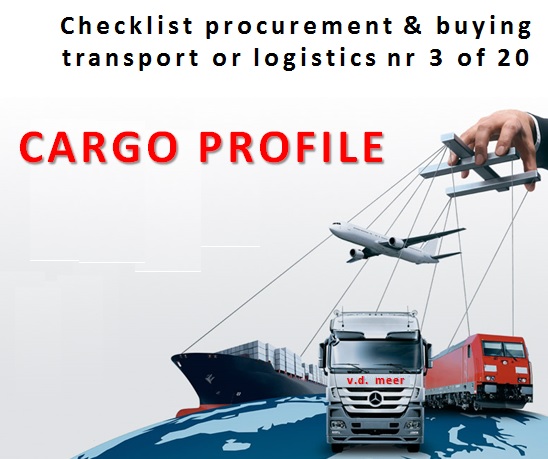







|
|
|
|
|

Tip 3 of 20 “Define cargo profile”
Unfortunately a lot of transportation tenders go south due to a false cargo profile definition.
In order to make a proper cargo profile we first have to figure out how to make one.
A cargo profile should inform your carrier how to plan, load, distribute, unload the cargo from A to Z.
So yes, the carrier needs to know virtually everything there is to know about the logistic setting.
We can roughly divide the cargo profile into 7 sections:
1. The cargo itself
2. Packaging of the cargo
3. Lead-time of the shipment
4. Shipment profile
5. Loading at the factory
6. Unloading at the customer
7. Equipment allowed
1. The cargo itself
Is it bulk material or packaged goods? Expensive or low value? Is it light or heavy? Sensitive to damage? Should it be transported climatized? Does it contain dangerous goods? In other words: describe your products as detailed as possible so your carriers knows how to handle it.
2. Packaging of the cargo
What about the pallet size? Always the same size and shape pallets? Do they have to be exchanged at the customer site? How high is the product stacked? Remember not all warehouses accept high pallets. What about the labels? Does it contain all the necessary info? Is it strapped and stable? Do you have a picture you could send with? Is the product wider than the pallet? Happens to big bags now and then. Do you have other figures like the weight of the pallet? How many of these pallets can be loaded into one truck?
3. Lead-time of the shipment
Not defining the lead time is killing anyway. Then your product will end up on a slow boat for sure! You need to define the lead-time starting with the needed order time, following by loading unto unloading at the customer. Especially at LTL (Less part loads) carriers need extra days to consolidate shipments. The number of days provided usually correspond with the quoted price. Quicker is more expensive.
4. Shipment profile
You probably will have a list with your shipments. New carriers want to know for example the regular size of your load. Do you have rather small shipments or do your customers order mostly 10 pallets or more. With large LTL shipments it doesn’t make sense to use a distribution centre and your carrier wants to do groupage on wheels. Therefore you need to describe the shipments, average size, postal code, countries etcetera.
5. Loading at the factory
Not all loading facilities are equipped with levellers or flexible dock shelters. You need to describe the accepted truck types. It happens a lot that low deck trailer or high volume trucks for example cannot dock at standard dock shelters. What about the procedures, should the carrier do a sign up or book timeslots? Although less problems occur at this item, it is worthwhile to check them out.
6. Unloading at the customer
At customer sites it is common that unloading facilities are far less equipped than at factory conditions. Small customer for example don’t have dock shelters, and sometimes they unload the cargo from the side with a forklift. Some customers don’t even have forklifts, which means you have to bring one. You need to map the unloading conditions at your customers.
7. Equipment allowed
What equipment is allowed? Curtain side trailer? What about theft during transit? Is it allowed to ship trailers unaccompanied with ferry’s? It all depends on your cargo profile. What about parking lots?
Examples I have seen the past:
Longer lead-times lead to lower pricing due to slower modalities, customers however demanded a much quicker lead-time so it failed
Package with unclear shipments: it appeared to consist of 80% LTL shipments whilst all carriers thought the tender package consisted of mainly of FTL shipments. The winner of the tender refused the package as he was not specialized in small shipments.
The winner of a tender used curtain side trailers, in praxis this was not possible due to theft. The winner didn’t have any box trailers and refused the package.
Tender with wrong specified height of the cargo. Suddenly mega, high volume trailers were needed. The winner didn’t have this kind of equipment
Bigs bags packed on the pallets where wider (overhang). Suddenly only 24 instead of 26 could be loaded. The prices per pallets had to be adjusted.
Imagine these problems occur after your nominated a new carrier, imposed existing carriers, made contracts etcetra. This is very embarrassing, painful but most of all costly since you have to negotiate the deal all over again!
|
| |
|
|
|
|
|
























